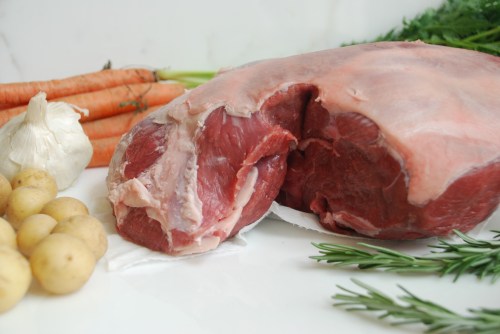
Easter is a big deal in Ireland…not like St. Patrick’s Day or Christmas…but special all the same. As you would expect, there are many religious customs associated with the holiday but, did you know, there are also a good few customs that are uniquely Irish? Waking at dawn to watch the sunrise on Easter morning, cake dances, clúdóg, mock herring funerals, and evening bonfires are amongst the truly old Irish Easter traditions.
In our Irish home, because we are a family that is both Irish and American, we borrow from the customs of our two home countries when celebrating Easter. This is how we make it work for us:
* Everyone will get a large chocolate egg, filled with smaller wrapped chocolates {as is done in Ireland}.
* The chocolate egg and a dozen hard-boiled, colourfully dyed, eggs will be hidden in the garden {assuming the weather cooperates} or in the house {if it doesn’t} by the Easter Bunny {as is done in America} and a family egg hunt will take place before we go the church.
* A basket, beribboned and filled with colourful tissue paper, will be left at the end of each person’s bed by the Easter Bunny {as is done in America}.
* All of us will get a new Easter outfit {as is done in both countries}.
* And, finally, after mass we will host or be a guest at a festive meal, where lamb or ham…or maybe both…will be the main course {as is done in both countries, for the most part..but most certainly in Ireland!}.
Lamb, in particular Irish Spring Lamb, is synonymous with Easter in Ireland. It is highly prized for its delicate flavour. I am convinced, based on the wee little guys we see frolicking in the fields near our home, that it is a diet of wild clover, grass and herbs that make it truly special. Unfortunately, Irish Spring Lamb expensive, But, if you’re only enjoying it every now and again, it’s well worth the splurge.

The recipe I’m sharing with you today comes from the book Cooking at Home by Julia Child and Jacques Pepin. It is incredibly easy to prepare and the meat requires almost no attention once in the oven. In our Irish home we serve roast lamb with either a homemade mint sauce or a simple gravy made from the pan juices of the roast and roasted spuds and peas for side dishes. For dessert, a lovely light pavlova with fresh fruit and lots of cream, is perfect after such a big meal.
From everyone in our Irish home to you and yours, we wish you a very happy Easter!
Jacques’s Roast Leg of Lamb
Serves 8-10
Ingredients
1 whole untrimmed leg of lamb, weighing about 6 pounds with shank and pelvic bone (trimmed of pelvic bone and most fat, about 4 3/4 pounds).
4 garlic cloves, peeled
salt
2 tablespoons fresh rosemary leaves, stripped off the stem
freshly ground black pepper
1 1/2 cups lamb stock, chicken stock, or white wine or a mixture of wine and stock
Directions
1.Prepare the lamb leg, removing the hipbone, trimming all fat, and scraping the shank bone.
2. For the herb seasoning, chop the garlic cloves coarsely. Pour a teaspoon of salt on top of the garlic and mash to a paste with the flat of the knife, then chop together with the rosemary leaves until they are finely minced
3. Thrust the tip of a sharp, thin-bladed knife into the thick top of the leg, about 1″ deep. Push about a 1/2 teaspoon of the seasoning paste into the slit with your finger. Make a dozen or more such incisions in the meaty parts of the leg, both top and underside, and fill with the seasoning. Rub any remaining paste over the boneless sirloin end of the leg. The leg may be roasted at this point or refrigerated for several hours or overnight, to allow the seasoning to permit the meat.
4. Prepheat the oven to 400ºF, arrange a rack in lower third of oven.
5. Just before roasting, sprinkle 3/4 teaspoon salt and 1/2 teaspoon of freshly ground black pepper over both sides of the leg. Set it on the roasting pan topside up.
6. Rost the leg for about 30 minutes, then turn the roast over, grasping it by the shank bone (with a thick towel or pot holder to protect your hands). Continue roasting for another 30 minutes or so (one to one-and-one-quarter hours total), depending on the size of the leg – until the internal temperature of the meat is about 125º to 130ºF when measured at the thickest part.
7. Remove the leg to a carving board or platter and rest – topside up – for about 20 minutes, allowing the meat to relax and reabsorb the natural juices.
8. Meanwhile, deglaze the roasting pan to make a simple sauce. Tilt the pan and pour off as much of the fat as possible. Place it over medium heat, pour in the stock and/or wine, and bring to a simmer, stirring and scraping up the browned glaze in the bottom of the pan. Strain the sauce into a bowl and add any juices released by the resting meat.
Additional Notes, Related Articles & Credits:
For more about Irish sheep and three recipes for cooking Irish lamb, see the New York Times Article: Erin Go Baa.
Is the Easter Bunny a Thing in Ireland? Check out the answer here at office mum.ie.
Random Irish Easter Traditions and the whole religious kit-and-caboodle may be read here at Claddaghdesign.com
More on Irish cake dances from Overland Monthly 1907 edition.


Thank you for sharing my Easter Bunny post and it’s lovely to discover your blog! I am endlessly fascinated by the differences and similarities between the US and Ireland, and I guess Easter is another one which is a mishmash of shared and not-quite-the-same traditions.
Happy Easter!
Your very welcome and thanks for writing back and checking out my blog too! It was fun to read your post about the Easter Bunny in Ireland. Over the many years I’ve lived in Ireland, it’s been interesting to watch the American customs creeping in. You can see why it happens (travel, tv, expats like myself moving in)…but still…I like Ireland keeping it’s traditions special. Would love to know your thoughts on Paddy’s Day. On the one hand I’m delighted to see us keeping up with NYC and Chicago…on the other hand, I love our local parades. And, God forbid we ever get so carried away as to put green food colouring in our drinks!!
[…] « Roast Leg of Lamb at Easter […]